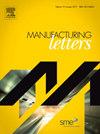Rotary ultrasonic surface machining of silicon: Effects of ultrasonic power and tool rotational speed
IF 2
Q3 ENGINEERING, MANUFACTURING
引用次数: 0
Abstract
The surging demand for monocrystalline silicon materials in the production of microelectronic components highlights its crucial role in the semiconductor and optic industries. Hence it is inevitable to produce a silicon workpiece with high quality finish to meet the demand in semiconductor industries. Due to high brittleness, controlling the quality of silicon in surface machining is quite difficult. Traditional manufacturing processes induce issues like rough surfaces and edge chipping. It was reported that rotary ultrasonic surface machining (RUSM) can effectively reduce cutting force, roughness, and edge chipping in machining of brittle materials. There have been several studies on drilling and sliding silicon materials using rotary ultrasonic machining investigating the effects of machining parameters on the output variables such as cutting force, torque, edge chipping, surface roughness etc. However, to the best of the authors’ knowledge, there are no reported investigations on effects of machining variables (ultrasonic power and tool rotation speed) in surface machining of silicon materials using the rotary ultrasonic machining. This study aimed to investigate the impacts of ultrasonic power and tool rotation speed on the cutting force, edge chipping, and surface roughness. Experimental results show that the ultrasonic vibration and tool rotation speed had a notable impact on edge chipping and cutting forces. Lastly, the current research has paved the way for widening the research on investigating grinding of the silicon wafer in semiconductor manufacturing with ultrasonic vibration and high rotation speed. In semiconductor wafer manufacturing, grinding process is used to reduce the flatness but generate surface and subsurface damage. With further investigations, RUSM can contribute to reducing these damages.
硅的旋转超声波表面加工:超声波功率和工具转速的影响
微电子元件生产对单晶硅材料的需求激增,凸显了它在半导体和光学行业中的重要作用。因此,为满足半导体行业的需求,生产出高质量的硅工件势在必行。由于硅的脆性很高,在表面加工中控制其质量相当困难。传统的制造工艺会导致表面粗糙和边缘崩裂等问题。据报道,旋转超声波表面加工(RUSM)可有效降低脆性材料加工中的切削力、粗糙度和边缘崩角。已有多项关于使用旋转超声波加工钻孔和滑动硅材料的研究,调查了加工参数对切削力、扭矩、边缘崩裂、表面粗糙度等输出变量的影响。然而,就作者所知,还没有关于使用旋转超声波加工硅材料时加工变量(超声波功率和刀具转速)对表面加工影响的研究报告。本研究旨在探讨超声波功率和刀具转速对切削力、边缘崩角和表面粗糙度的影响。实验结果表明,超声波振动和刀具转速对边缘崩角和切削力有显著影响。最后,目前的研究为拓宽研究半导体制造中硅晶片的超声波振动和高转速磨削铺平了道路。在半导体晶片制造过程中,研磨工艺用于降低平面度,但会产生表面和次表面损伤。随着研究的深入,RUSM 可以为减少这些损伤做出贡献。
本文章由计算机程序翻译,如有差异,请以英文原文为准。
求助全文
约1分钟内获得全文
求助全文
来源期刊

Manufacturing Letters
Engineering-Industrial and Manufacturing Engineering
CiteScore
4.20
自引率
5.10%
发文量
192
审稿时长
60 days
 求助内容:
求助内容: 应助结果提醒方式:
应助结果提醒方式:


